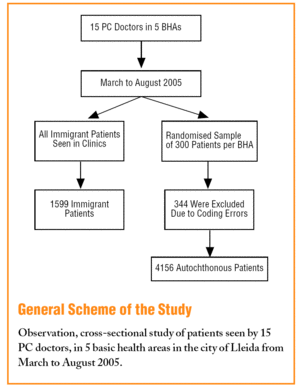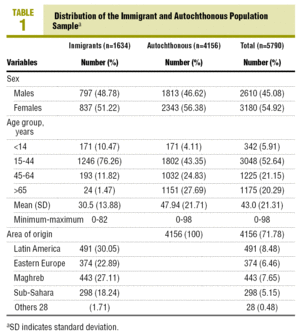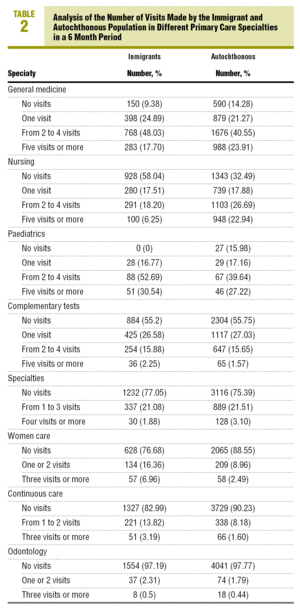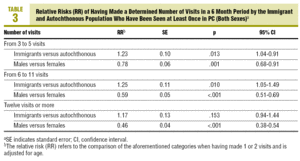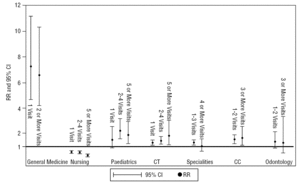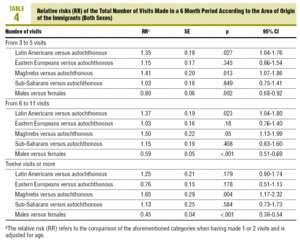Introduction
The rate of growth of the immigrant population in Spain has been relentless over the last few years. Once the immigrants are settled in Spain and they require medical care, one of the first places that they look for help is health centres and emergency services, as they are the first points of access to the health system.1 It has been reported that there can be barriers to accessing certain parts of the health system, mainly due to ignorance of the language and socio-cultural differences.2,3
As this immigration phenomenon in Spain is very recent, there is still a lack of published medical literature evaluating these aspects in this group.1,4 To find out their behaviour as public health users seems necessary and is justified in order to design and establish policies in order to adapt to the present and future needs of the health system.
The objective of this article is to evaluate and compare the use of resources in the different primary care (PC) services between immigrants and the autochthonous population who come into contact with PC services.
Methods
Study Type
A cross-sectional observational study carried out on a population seen in PC.
Study Population
The study population consists of patients seen by 15 PC doctors in 5 basic health areas (BHA) of the Catalonia Health Institute in the city of Lleida, and located in districts with a higher percentage of immigrant population according to the 2004 Municipal Inhabitants Register.5 The study was carried out over 6 months (March to August 2005).
Participants
All those patients coded as immigrants were extracted from all the patients who arrived at the 15 clinics during the 6 month period of the study. To ensure that all the immigrants who visited the 15 participating doctors were included, a list of patients seen during the study period was checked and the immigrants who did not have details of their country of origin then coded. In this way, a total of 1599 patients of immigrant origin was obtained, which was the total number of immigrant patients seen during the study period.
To obtain the sample of the autochthonous population who had been seen during the study period, a simple randomised sample of 300 patients was taken in each of the 15 participating basic health units (BHU), thus obtaining a total sample of 4500 patients. Of these, 344 were excluded after individual reviews by the participating doctors, exclusions due to coding errors, giving a total of 4156 patients of Spanish origin remaining in the study.
As has been done in other studies,6,7 the areas of origin which represent the largest groups in the city of Lleida during the study period, were: Latin America, Eastern Europe, Maghreb, Sub-Saharan Africa, and other countries. Patients coming from developed countries have not been included in the comparative analysis of autochthonous and immigrant subjects.
The study variables were introduced into the e-CAP computer program.
Analysed Variables
The variables analysed were, age, sex, type of visit made, and referrals made. The autochthonous population was considered as those whose country of origin was Spain and the immigrant population those from low and medium income countries, regardless of the time of residence in the BHA.
Ethical Aspects
Confidentiality and anonymity of the participating subjects has been maintained at all times.
Calculation of the sample size was made based on two conditions: a) to obtain exact estimates by area of origin of the patients, and b) to be able to use multivariate models to make adjustments for possible age and sex differences between the immigrant and autochthonous population who were seen in PC. To determine the sample size, the number of patients in the city of Lleida that could be included and came from each of the most representative areas (Latin America, Eastern Europe, Maghreb, and Sub-Saharan Africa) was calculated. For estimating the proportions with a precision of 5%, assuming the worst case (proportions around 0.5), 385 patients per area of origin would be needed. This is equivalent to an immigrant sample of approximately 1600. As regards the autochthonous patients, the 4156 included in the study ensured a high precision in the estimation of proportions and means in this global group, analysed by age and sex. The autochthonous group is larger than the immigrant group and also because the information was available. Obtaining information was not an additional cost. Likewise, the number of subjects studied enabled multivariate models to be used to be able to adjust the comparison of variables for age and sex, according to the group origin.
Statistical Analysis
The frequency of use of the different PC services during the 6 months is described according to age, sex, autochthonous group, immigrant group, and area of origin, using the mean, median, and standard deviation. The number of visits by specialty is grouped into categories which varied according to the frequency of visits in that specialty. Later, the percentage of patients in each of the categories was obtained (e.g., no visits, 1 visit, from 2 to 4 visits, and 5 or more visits).
To analyse the association between frequency of use and the group or area of origin (immigrant/autochthonous), multinomial logistic regression models were used, which estimated the relative risk (RR) and its confidence interval (CI), adjusting for age and sex.
To evaluate the statistical significance of coefficients of the models, a likelihood ratio test was used. The Hosmer-Lemestow C statistic has been used to compare the expected and observed individuals in the different risk quartiles of having a determined number of visits, for each of the model logits. The models presented are well calibrated (P value of the C statistic >.05).
Results
Women made up 51% of the immigrant group, and 54% in the autochthonous group. The distribution by age and by country is set out in Table 1. The mean age of the immigrants was 30 years compared to 45 years in the autochthonous group. In the 1599 immigrant patients studied, the mean number of visits in the 6 month period was 5.1 for males and 7.4 for females, with a visits median of 4 and 6, respectively. In the autochthonous group, the frequency was 7.2 visits for males and 8.4 for females, with a visit median of 5 and 6, respectively.
The total visits made are classified into the different existing specialties, and are group into frequency of use categories as shown in Table 2 (no visits, 1, from 2 to 4, and finally more than 5 visits).
To analyse the association between frequency of use and the group or area of immigrant origin, multinomial regression models were used, including all the patients studied and adjusting for age (Table 3). In the results of the adjusted model it was seen, with significant statistical differences, that among the population who had gone at least once to a PC clinic, the immigrants had a relatively higher probability than the autochthonous population to make from 3 to 11 visits, against 1 or 2 visits. It is also observed that women have a higher probability of visiting compared to men in all the visit categories.
By using a multinomial regression model to estimate the RR of having made a visit for each existing category (Figure), we found that the RR was higher in the immigrants for all categories, except in nursing. For example, for the general medicine category, the probability of having been seen is approximately seven times higher in the immigrant than in the autochthonous population. These differences found are maintained by country of origin of the immigrant (Table 4).
FIGURE 1 Relative risks (RR) of having made a determined number of visits in a 6 month period by the immigrant and autochthonous population who have been seen at least once in PC (both sexes).Dependent variable: not having made any visits. The RR compares immigrants against autochthonous population. CC indicates continuous care; CT, complementary tests.
Discussion
The results of this study show that in individuals who have been in contact with PC services at least once, the RR adjusted by having visited family medicine is much higher in the immigrant group compared with the autochthonous population, except the frequency of being seen by nursing professionals, where the risk was found to be less. It could be that immigrants need to see the family doctor more to solve problems of equal complexity to those that the autochthonous problem has and that, however, they may see nurses less do to them being a group that uses acute services more. As the increase in the use of services is restricted to whoever uses them, the discrepancy in the visits average (probably due to the higher number of immigrants with no visits) suggests that when they do go to the health services they do so due to having a more complicated, or more difficult to resolve clinical picture, as supported by the higher number of complementary tests requested for the immigrants. The possible ignorance or lack of information that foreigners may have as regards nursing functions, also cannot be ruled out.
It is well known that the general autochthonous population use PC services with a certain regularity,9 and similarly it is established that the immigrant group are doing this.10
Therefore, in a community based study in Madrid, carried out over 2 months in 1997,11 of the 300 immigrants interviewed, 84% stated that they had used some health service in Spain, and 65% of them, PC services.
It has not been possible to compare the frequency of use of our participants with those published in other works, because a general population sample has not been used in the design. In population design studies it seems that the immigrants use services less than the autochthonous population,12 and that there is a predominance of female immigrants when visiting clinics.10
As regards gynaecology, it was found that the RR of being seen in a clinic was higher for the immigrant group, a fact that may be explained by its higher birth rate.13 These differences were also found according to the area of origin and, statistically significant in the Latin American, Maghreb, and Sub-Saharan group. Studies have been carried out that demonstrate that the need for maternity-neonatal care is increasing in this population group (Report "Immigrant Health").14
In a study carried out in Canada,15 a country which has a health system similar to ours, in that it is universal, they report problems as regards adequate accessibility by immigrants to the public health system.
The difficulty in arranging the documentation to legalise their residency or health cards are significant bureaucratic barriers.
These difficulties are similar to those that occasionally occur in Spain. On comparing the frequency of use data obtained in our study with those of other studies carried out in other countries, it is evident that our universal health system makes it easier to have greater health cover.
It is also known that the increase in the demand for emergency services is due to social changes, the "medicalisation" of daily life and the tendency of the user towards rapid services.16,17
The greater use of emergency services, particularly by groups from the lower socio-economic strata, could be explained by a lower level of health and also due to inadequate use of the service; they go less often to their primary care centre, and they occasionally visit several centres for the same problems in a short space of time. It has been reported in previous studies that to have a lower income level, a smaller sized home and dedicated to housework, is associated with a higher frequency of visits to the family doctor in PC.18
As main limitations of the study, it has to be pointed out that only those patients who attended clinics have been analysed and not a general population. Also, as has been done in previous studies, non-registered users and non-residents were not included to avoid confounding factors, due to the belief that these might have a different behaviour pattern in using health services.10,12
Another aspect to take into account is that of double health cover (public and private), since this could mean that part of the population that uses it may use more health services that are not public. If this situation is occurring differentially in the autochthonous population, it could explain why this group uses public services less compared to the immigrant group.
In previous studies carried out in Catalonia, it has been mentioned that having access to private medicine was more common in the upper social class group.19 However, the data bases we have available do not let us know these patient characteristics. On the other hand, neither do we know how many immigrants are seen by non-governmental organisations or are treated in the fields of alternative medicine.1
There are many factors that produce differences in the frequency of use by patients, and the psychosocial variables do not explain the major part of this variability in frequency of use.20 We do not know the psychosocial variables of the patients studied, thus we are unable to compare the results obtained by other authors.
As a line in future investigations, we consider, that given the large amount of foreigners who come into contact with the public health system, the role of PC in how to handle the health of immigrants needs to be made clear. PC as an entrance gate for the whole population has to become the central ladder of the health system, and for this reason organisational strategies must be developed that can guarantee that health care is given, avoiding or minimising the barriers to accessibility and, therefore, under the same conditions as those of the autochthonous population.
As regards the results that we have found (Table 4), it is possible that that there are also differences in the frequency of use between the different immigrant groups, particularly by Latin Americans and those from Maghreb. Therefore it appears that language is not the main barrier, since the Latin American population, for whom these barriers are non-existent or are reduced to slight variations in use, are more frequent users to a larger extent than the rest of the immigrant groups. Spain, as a receiver of a high percentage of immigration coming from low income countries with a common language, provides a unique opportunity to evaluate the effect of language barriers in the frequency of use of the health services.
Given the significant differences in the frequency of use of nursing professional services, we believe that studies should be performed in specific settings, which would enable us to find out the reasons for this lower number of consultations observed compared to that of other professionals.
In conclusion, immigrants who go to PC are seen more in family medicine and gynaecology, and have a higher number of complementary tests than the autochthonous population. However, the frequency of use of nursing visits is lower than that recorded for the autochthonous population. Therefore, we suggest that the importance of immigration in the Spanish health system has to be taken into account when planning agendas and distribution of resources in primary care.
Acknowledgements
To the colleagues of the PC centres who have taken part by seeing and recording the patients included in this study.
Funding: This work was carried out with a grant from the Spanish Society of Family and Community Medicine (semFYC).
What Is Known About the Subject
• Immigrants coming from low income countries are mainly young people who are generally in good health.
• Due to the immigration being a recent phenomenon in Spain, there is still very little published in the medical literature on the behaviour pattern of immigrants as regards health services.
• When medical assistance is needed, one of the first places the immigrants look for help is in health centres and emergency departments.
What This Study Contributes
• Immigrants have a different pattern of use from the autochthonous population.
• The relative risk of being seen in general medicine is 7 times higher than the autochthonous population, but they do not use nursing services as much.
• More complementary tests are carried out on immigrants and the frequency of use of the different specialties and gynaecology services is higher.
Spanish version available
www.doyma.es/220.114
A commentary follow this article
(page. 232)
Correspondence: J. Soler González.
Avda. del Segre 3, 5.º, 2.ª.
25007 Lleida. España.
E-mail: jorgesolergonzalez@gmail.com
Manuscript received: August 1, 2007.
Manuscript accepted for publication: October 1, 2007.













